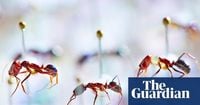In the lush, isolated islands of Fiji, a quiet crisis is unfolding beneath the forest canopy and within the leaf litter: ants, those industrious and often-overlooked insects, are vanishing at an alarming rate. This isn’t just an isolated incident—scientists warn it’s a stark sign of a much broader global trend, sometimes dubbed the "insect apocalypse." Recent research, published September 11, 2025, in Science by a team from the Okinawa Institute of Science and Technology (OIST), brings this crisis into sharp focus, revealing that 79% of Fiji’s native ant species have declined since humans first set foot on the islands roughly 3,000 years ago. But most startling is the accelerated collapse in just the past few centuries, coinciding with European colonization, the onset of global trade, and the rise of modern agriculture (as reported by Science X and MK News).
To piece together this troubling story, the OIST team, led by Professor Evan Economo, turned to community genomics and the treasure troves of museum collections. By analyzing the genomes of thousands of ant specimens collected over decades, the researchers reconstructed the evolutionary relationships and population histories of more than a hundred Fijian ant species. This approach, sometimes called "museumomics," allows scientists to peer back in time and estimate whether populations have been waxing or waning—even when direct monitoring wasn’t possible. As Dr. Economo explained to Science X, "It can be difficult to estimate historical changes to insect populations, because with few exceptions, we haven't been directly monitoring populations over time. We take a novel approach to this problem by analyzing the genomes of many species in parallel from museum specimens collected recently. The genomes hold evidence of whether populations are growing or shrinking, allowing us to reconstruct community-wide changes."
The results are sobering. Not only are the majority of Fiji’s endemic ant species in decline, but the timeline of their downfall tracks disturbingly well with major human milestones. The first signs of trouble emerged after humans arrived about three millennia ago, but the real nosedive began in the last 300 years. This era saw Fiji swept up into the currents of European contact, global trade, and agricultural transformation. Meanwhile, non-native ant species—recent arrivals, often hitching rides with humans—have been thriving, with some populations exploding in size. The researchers identified a total of 65 separate colonization events, from ancient natural arrivals to modern human introductions. As Dr. Cong Liu, first author of the study, pointed out, "Being closed, isolated ecosystems, islands are expected to feel the effects of human impact faster, so they are kind of a canary in the coal mine."
This Fijian case study is far from unique. According to a September 12, 2025, report by MK News, insect populations worldwide are plummeting by about 2.5% each year, with hundreds of thousands of species lost over the past 150 years. Researchers warn that if this trend continues, the world could soon face a tipping point—one that could threaten the very fabric of Earth’s ecosystems. Insects, after all, are the unsung heroes of nature: they pollinate crops and wild plants, decompose organic matter, and help cycle nutrients through soil and water. Lose them, and the consequences could ripple through food chains, agriculture, and even human survival. The United Nations Food and Agriculture Organization (FAO) notes that honeybees alone are responsible for pollinating 71 of the top 100 major crops, accounting for 90% of the world’s food supply. Imagine a world without avocados, berries, cucumbers, or even honey for your salad dressing—such a scenario isn’t as far-fetched as it might sound.
What’s driving this global decline? The culprits are many and interlinked. Habitat loss—think shrinking wetlands, forests, and grasslands—pesticide use, and light pollution all take their toll, but climate change is emerging as a particularly insidious threat. A NASA study published in Nature Climate Change in 2022 predicted that up to 65% of insect populations could vanish in the next century due to temperature shifts alone. By integrating climate models with insect-specific temperature tolerances, NASA researchers found that 65% of the 38 insect species they studied (including aphids and wasps) could go extinct within 50 to 100 years, largely because many insects—especially cold-blooded species—cannot adapt to increasingly erratic and extreme temperatures.
This isn’t just theory. University of Sydney scientists reported in 2019 that 40% of the world’s insect species are already declining due to climate change. The University of Ottawa found that North American bumblebee populations have halved since the early 20th century, and a 2021 University College London analysis in Nature revealed that insect numbers are nearly 49% lower in areas heavily affected by climate change. These findings are echoed by a new study from the University of North Carolina at Chapel Hill, highlighted by NPR on September 12, 2025. Over 15 summers in a remote Colorado mountain meadow, researchers found a 6.6% annual drop in flying insects—a staggering 72.4% decrease over two decades. What’s striking is that this decline occurred in an area largely untouched by direct human activity, suggesting that climate change alone is enough to trigger catastrophic losses.
Keith Sockman, the study’s lead author, told NPR, "There's very little human development in the immediate vicinity or within several kilometers... So it doesn't seem likely that there's any direct impact on land or water use changes caused by humans that could account for this [population decline]. That doesn't leave a lot of other options other than changing climate to explain this." University of Kentucky entomologist Jonathan Larson, commenting on the findings, put it bluntly: "Insects are some of the foundational organisms to our planet... They play a large role in the success of not only us, but every other living thing on Earth."
The Fijian ant study, with its pioneering use of museum genomics, also underscores the value of biodiversity collections for conservation. As Professor Alexander Mikheyev of the Australian National University told Science X, "As our scientific toolbox expands, there is more and more information that we are able to capture from biodiversity collections, so it's essential that we continue investing in and maintaining these vital resources." The OIST team is now extending its efforts to monitor insect populations in Okinawa in real-time, using acoustic monitoring and trapping through the Okinawa Environmental Observation Network (OKEON).
What’s needed now, experts say, is a dramatic expansion of insect monitoring and research, especially in understudied regions and ecosystems. As the evidence mounts, the message grows ever clearer: insects are not just background characters in the story of life on Earth—they are central to its plot. Their decline is a warning we can’t afford to ignore, and the time to act is now.





